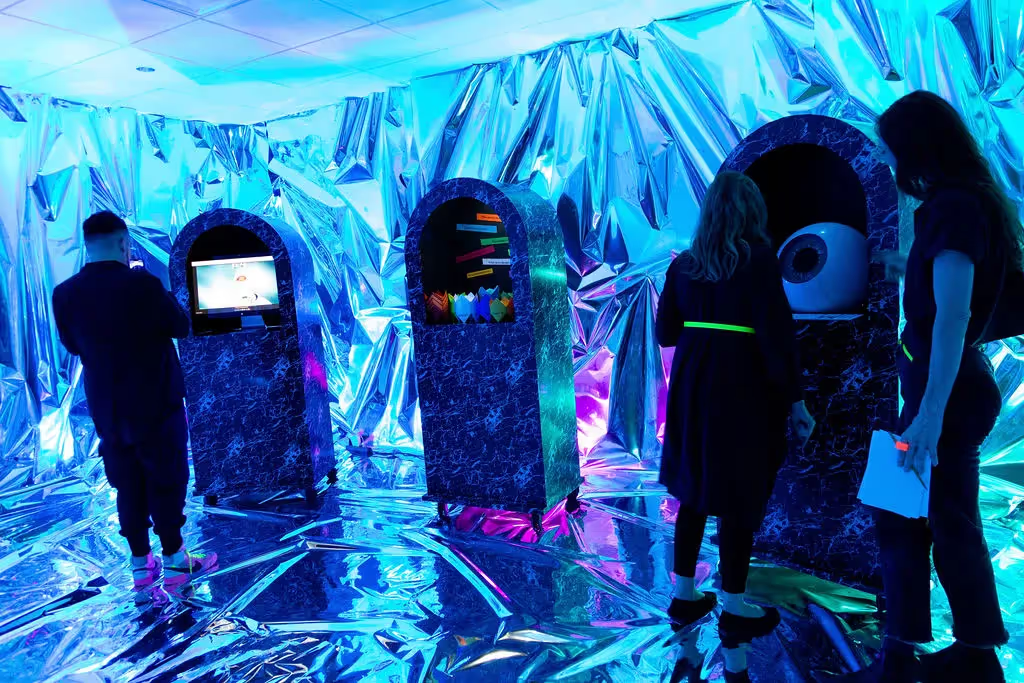A choice between two decision-makers
The company, an industry-leading global creative consultancy known for designing the first Mac computer, sponsored the Design Track of this year’s festival.
At its event, each room had a unique focus. The one inherited by frog’s Head of Interaction Design Ryan Flynn and Sr. Interaction Designer Briana Mazzio was designed to illustrate humanity’s paradox of choice.
Together, Flynn and Mazzio set out to see if—under the right conditions—people would give up their right to make their own decisions. More specifically, they wanted to test whether people would allow artificial intelligence to make decisions for them.
Flynn and Mazzio built two proxy decision-makers. The first one, which was clearly a machine, spoke directly to attendees through an all-seeing eye. The second one, which looked like an alien, interfaced with attendees through virtual reality. Both bots, which were instructed to act as trusted advisors, asked one question: “What decision can I help you make today?”

Some attendees asked surface-level questions, like “What should I drink next?” or “Where can I find the best french fries in Austin?” Others probed deeper, inquiring about how to make their relationship more novel, or how to guide their children toward the best vocation. One person even broached the subject of getting rid of a dead body.
What was most interesting was how the decision-makers influenced people’s questions. Contrary to Mazzio’s hypothesis that people would feel more comfortable interacting with a sentient being, people were more vulnerable and less self-conscious when speaking to the machine. Mazzio believes this was the case because they didn’t perceive the same judgment from the all-seeing eye.
In the absence of social repercussions, people also took their time, repeating their question several times until they got the answer they were looking for—something that may have otherwise been considered rude.

“It’s amazing how quickly people adapted to the technology,” said Flynn.
The attendees’ curiosity quickly turned into excitement. Most were impressed by the conversational nature of the decision-makers, which was augmented by a natural-sounding voice. Even people familiar with LLMs like ChatGPT were blown away by how thorough and thoughtful the bots’ responses were.
While frog didn’t conduct an official poll, the consensus in the office was that the "paradox of choice" room was the guest favorite.
“It was almost chaotic how many people were coming in to interact with the decision-makers,” said Mazzio. “People were clearly enjoying themselves.”

Making the magic happen
Mazzio and Flynn were delighted by the chance to participate.
“When someone says they’ll pay you to do something fun at SXSW, you jump at the opportunity,” said Mazzio.
The whole production took about a month of preparation. Flynn and Mazzio spent a few hours per day coming up with a compelling concept, solidifying the prototypes, and decorating the event space. Onsite, Mazzio used materials like foam core, contact paper, and hot glue to set the scene.
“We wanted to create something surreal that would break people out of their everyday realities,” said Mazzio.
To their surprise, the fastest part was designing the bots in Voiceflow.
“Within a couple of minutes, we were able to make something operational,” said Mazzio. “I was shocked by how easy it was.”

Are we still alone in the universe?
This experiment opened Mazzio’s eyes to how close we are to consulting machines on personal matters.
“I think they’ll grow into trusted advisors, like a friend or family member,” said Mazzio. “They’ll flesh out our social sphere.”
Flynn quickly agreed: “If AI begins to develop a long-term memory, that’s when our interactions are going to get really blurry and start to feel more human.”
Flynn predicts that brands will soon tailor AI to their needs by equipping these intelligent machines with historical company knowledge and a personality.
But that’s just the tip of the iceberg, the two designers argued.
Today, companies must choose whether to personalize or scale. But, in the future, Mazzio believes AI will help businesses do both—improving the customer experience while achieving unprecedented efficiencies.
With this capability, Flynn thinks AI will democratize healthcare—extending access to people who can’t afford key medical services.
“A replacement for humans may be closer than we think,” said Mazzio.
A choice between two decision-makers
The company, an industry-leading global creative consultancy known for designing the first Mac computer, sponsored the Design Track of this year’s festival.
At its event, each room had a unique focus. The one inherited by frog’s Head of Interaction Design Ryan Flynn and Sr. Interaction Designer Briana Mazzio was designed to illustrate humanity’s paradox of choice.
Together, Flynn and Mazzio set out to see if—under the right conditions—people would give up their right to make their own decisions. More specifically, they wanted to test whether people would allow artificial intelligence to make decisions for them.
Flynn and Mazzio built two proxy decision-makers. The first one, which was clearly a machine, spoke directly to attendees through an all-seeing eye. The second one, which looked like an alien, interfaced with attendees through virtual reality. Both bots, which were instructed to act as trusted advisors, asked one question: “What decision can I help you make today?”

Some attendees asked surface-level questions, like “What should I drink next?” or “Where can I find the best french fries in Austin?” Others probed deeper, inquiring about how to make their relationship more novel, or how to guide their children toward the best vocation. One person even broached the subject of getting rid of a dead body.
What was most interesting was how the decision-makers influenced people’s questions. Contrary to Mazzio’s hypothesis that people would feel more comfortable interacting with a sentient being, people were more vulnerable and less self-conscious when speaking to the machine. Mazzio believes this was the case because they didn’t perceive the same judgment from the all-seeing eye.
In the absence of social repercussions, people also took their time, repeating their question several times until they got the answer they were looking for—something that may have otherwise been considered rude.

“It’s amazing how quickly people adapted to the technology,” said Flynn.
The attendees’ curiosity quickly turned into excitement. Most were impressed by the conversational nature of the decision-makers, which was augmented by a natural-sounding voice. Even people familiar with LLMs like ChatGPT were blown away by how thorough and thoughtful the bots’ responses were.
While frog didn’t conduct an official poll, the consensus in the office was that the "paradox of choice" room was the guest favorite.
“It was almost chaotic how many people were coming in to interact with the decision-makers,” said Mazzio. “People were clearly enjoying themselves.”

Making the magic happen
Mazzio and Flynn were delighted by the chance to participate.
“When someone says they’ll pay you to do something fun at SXSW, you jump at the opportunity,” said Mazzio.
The whole production took about a month of preparation. Flynn and Mazzio spent a few hours per day coming up with a compelling concept, solidifying the prototypes, and decorating the event space. Onsite, Mazzio used materials like foam core, contact paper, and hot glue to set the scene.
“We wanted to create something surreal that would break people out of their everyday realities,” said Mazzio.
To their surprise, the fastest part was designing the bots in Voiceflow.
“Within a couple of minutes, we were able to make something operational,” said Mazzio. “I was shocked by how easy it was.”

Are we still alone in the universe?
This experiment opened Mazzio’s eyes to how close we are to consulting machines on personal matters.
“I think they’ll grow into trusted advisors, like a friend or family member,” said Mazzio. “They’ll flesh out our social sphere.”
Flynn quickly agreed: “If AI begins to develop a long-term memory, that’s when our interactions are going to get really blurry and start to feel more human.”
Flynn predicts that brands will soon tailor AI to their needs by equipping these intelligent machines with historical company knowledge and a personality.
But that’s just the tip of the iceberg, the two designers argued.
Today, companies must choose whether to personalize or scale. But, in the future, Mazzio believes AI will help businesses do both—improving the customer experience while achieving unprecedented efficiencies.
With this capability, Flynn thinks AI will democratize healthcare—extending access to people who can’t afford key medical services.
“A replacement for humans may be closer than we think,” said Mazzio.





.svg)